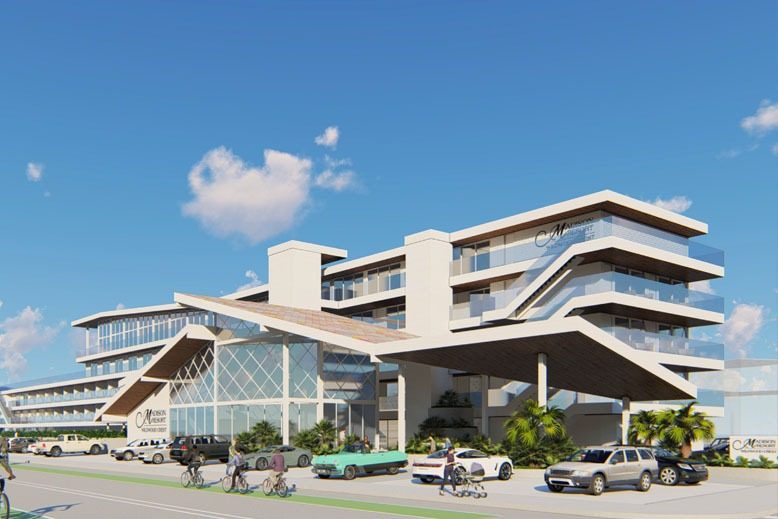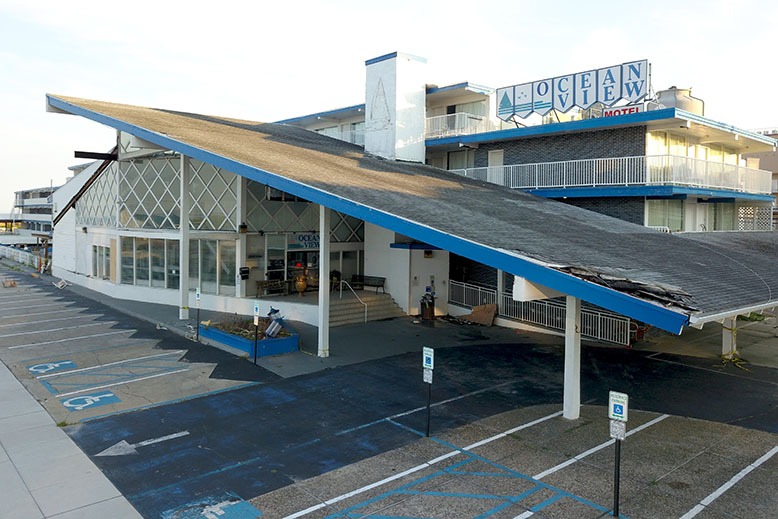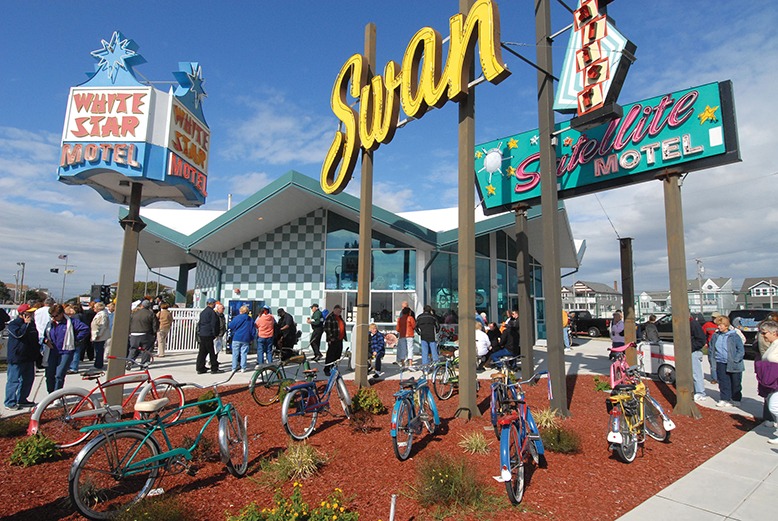
At a prime corner in Wildwood Crest, developers are making a $28 million investment in the staying power of Doo-Wop—the funky, mid-century design style that came to define a Shore resort town and that has been under considerable threat for more than two decades.
Madison Resorts has reimagined the 100-plus-room motel that opened as the Admiral in 1963, and this spring set about rebuilding its iconic jet-age lobby—hewing to its original design, with an asymmetrical blast-off roof that evokes the futuristic airport terminals of the 1960s. It is expected to open by the end of July.
The Cape May-based developer bought the property, most recently called the Oceanview, after another plan to replace the deteriorating motel with a boxy condominium project faltered, much to the relief of Doo-Wop enthusiasts who have seen many of the unique motels on this barrier island at New Jersey’s southern tip meet similar fates.
“We had been watching what was going on in the Wildwoods as a whole—there were a lot of condo conversions and townhouses—and it was sad to hear of the Oceanview going condo,” says Madison CEO Dan Alicea. “We kind of swept in and said, ‘Let’s keep Doo-Wop alive.’”

A shot of the old Oceanview property, prior to renovations by Madison Resorts. Photo: Courtesy of Madison Resort Wildwood Crest
Wildwood, North Wildwood, Wildwood Crest and West Wildwood—collectively known as the Wildwoods—are home to one of the biggest collections of Doo-Wop architecture in the world, with the largest concentration found along a two-mile stretch in the Crest.
The term Doo-Wop, taken from 1950s pop music, was applied to architecture and design as the style came under siege in the 1990s. It describes the colorful, space-age flair of the mid-century construction that supplied the Wildwoods with nearly 300 low- to mid-rise motels and an assortment of restaurants and attractions.
There was a template: two- and three-story motels wrapped around a small pool, usually concrete, with shuffleboard courts to the side. But the Doo-Wop adornments made each unique: jutting or curved roof lines, geometric railings, bright colors. Each motel adhered to a theme, often evoking the Atomic age, like the Satellite and the Stardust, or the era’s fascination with tiki, found at the Royal Hawaiian and Waikiki. Some were just about fun, like the Lollipop, the Carousel and the Pink Champagne.
The style had a decidedly kitschy flair that brought plastic palm trees and lots of colorful neon signs to the Jersey Shore. The building boom started shortly after the Garden State Parkway opened in the mid-1950s—beckoning motoring families from North Jersey, Philadelphia and French-speaking Canada, of all places. (Thousands of Quebecois still make the 21-hour round trip to the Wildwoods’ wide beaches each summer, and it’s common to hear French spoken on the three-mile boardwalk.)

A Doo-Wop tour in the Wildwoods showcases years of unique architecture. Courtesy of Greater Wildwoods Tourism Improvement & Development Authority
By the late 1960s, there were as many as 300 Doo-Wop motels in the Wildwoods. Most were small—less than 50 rooms—and many were family run.
Thirty years later, many of the buildings were overdue for maintenance and susceptible to the condo boom that had begun to remake the island, replacing motels that catered to middle-class families with higher-end housing. Tourists wanted amenities like central air, which many of the older motels lacked. It’s estimated that as many as half the Doo-Wop motels were lost to the wrecking ball or condo conversion since the 1990s.
“We realized how fragile [the Wildwoods] were in the ’90s,” says Jack Morey, who, with others, founded the Doo Wop Preservation League in 1997, with the vision that the future of tourism in the Wildwoods was rooted in the recent past. “We needed to reinvent the town based on the attributes that were there. We have the largest collection of mid-century architecture, the biggest beaches and the biggest boardwalk.”
Anyone who has spent any time in the Wildwoods will recognize Morey’s name, as his family owns and manages the biggest attractions on the boardwalk. The family built many of the Doo-Wop gems.
The goal of the league is not preservation per se, but rather, encouraging developers to maintain the mid-century vibe, even with new construction.
There have been successes. The Caribbean in the Crest is a popular boutique motel that is updated vintage, inside and out. The Convention Center and the Wawa on Rio Grande Avenue were both built nearly 50 years after the Doo-Wop era, but elevate their style with wavy neon and angular rooflines.
Morey says he put his money where his heart was with the StarLux—a vintage motel near the boardwalk that was gutted and remade in 2002. A two-story glass lobby with jutted roof was added, as well as a kidney-shaped pool (of course!) with boomerang inlays.
“Finding the balance between fresh, good-looking and tacky—that’s an art and a science, and I work really hard at that,” says Morey, speaking from the site of his latest project just north of Wildwood, a nine-hole golf course he says will embrace that fun vibe. The logo for Morey’s Big Little Nine features a classic 1960s happy face.
Progress has been made to celebrate the kitschy-ness that endeared the Wildwoods to generations of vacationing families, says Morey. The Doo Wop Experience museum (which made NJM’s guide to under-the-radar museums), open seasonally in Wildwood, has assembled a treasure trove of artifacts, including vintage neon motel signs. It’s housed in a former restaurant with a classic mid-century modern folded-plate (zig-zag) roofline.
Still, every vintage neon sign lost to the landfill, every classic pink-tiled bathroom chipped apart, makes Doo-Wop aficionados wince. A new round of anxiety comes each spring, when longtime motel owners entertain the idea of selling and cashing in on the state’s soaring land prices. In March of 2023, there were a half a dozen motels for sale in the Wildwoods, including a couple of small, vintage, mom-and-pop properties: the 21-unit Starfire and the 22-unit Casa Del Sol, both on Ocean Avenue in Wildwood.
The Madison project will preserve the Doo-Wop character of one of the island’s largest motels that is at the center of the Wildwood Crest motel district, recognized by the state for its historic significance. The investors purchased the oceanfront property at the corner of Ocean Avenue and East Rambler Road for $10 million and have budgeted another $18 million to rebuild and renovate, says Alicea, who grew up spending summers in the Wildwoods.
Plans to preserve the existing lobby had to be scrapped because the structure was in such bad shape after years of neglect, but the rebuild will replicate its design, Alicea says. All mechanical systems are being upgraded, and a restaurant is being added.
Don Cabrera, mayor of Wildwood Crest, says the Madison project is a “good opportunity to preserve and modernize Doo-Wop…. It’s a good balance. It will take it up a notch.”
Preservationists remain concerned that there are no mandated zoning and planning guidelines to incorporate Doo-Wop into new projects, but informally, enough developers seem to be getting on board.
The preservation league “put together a manual on how to Doo-Wop, meeting with and encouraging developers to use mid-century elements in construction,” says Ben Rose, director of marketing and public relations at the Wildwoods Convention Center. “It’s not so much preservation of the original building, but rather preserving the look and vibe that exists in the Wildwoods.”
The league is trying to “get to a point where we can convince planners and developers that there should be design guidelines—ones that don’t stunt growth,” says John Donio, the league president and head of the Wildwood Business Improvement District. “We don’t want another beige box; it’s more profitable and there are more jobs that can be created by embracing the design.”
This is Donio’s twenty-third season running the Daytona Inn and Suites, a classic 41-unit Wildwood motor lodge that he’s been upgrading while preserving the Doo-Wop vibe. “I’m a businessman first, a preservationist second. I’m also a design guy, and I know that there’s dollars behind design,” he says, noting that visitors often stop to post pictures on Instagram of the Daytona’s classic neon sign featuring a race car and colorful racing flags. “That’s free advertising!”
Doo-Wop fans say the style separates the resort from cookie-cutter beach towns in the way that leaning into its Victorian roots has allowed neighboring Cape May to become a year-round destination. And they point to Miami’s embrace of its vintage architecture in the rejuvenation of South Beach. “What Art Deco is to South Beach, Doo-Wop is to the Wildwoods,” Rose says.
Patricia Alex is a former reporter and editor at The Record in northern New Jersey.
No one knows New Jersey like we do. Sign up for one of our free newsletters here. Want a print magazine mailed to you? Purchase an issue from our online store.
